Outboard boat motors are reliable, efficient, simple to maintain, provide lots of horsepower, and are easy to upgrade. Outboard motor maintenance is simplified in this easy-to-follow checklist. Learn how to properly assess your outboard motor before every outing, and how to maintain your outboard motor throughout the year.
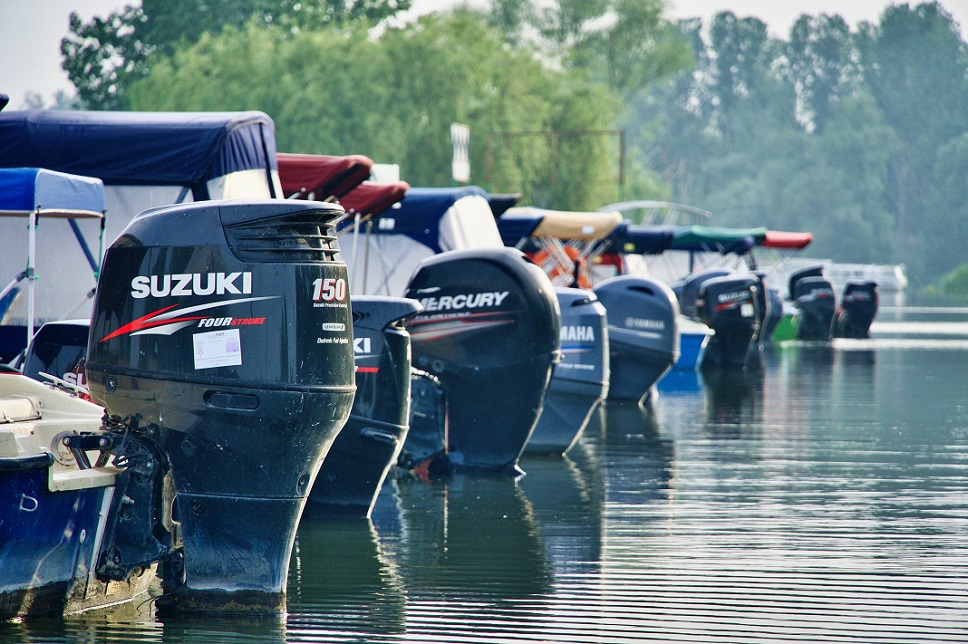
Outboard motors are reliable and efficient. Mercury, Yamaha, and Suzuki are among the best quality brands of outboard motors.
#1 CHECK YOUR FUEL AND SUPPLY LINES
The first thing before starting your engine is to inspect your fuel tank and fuel supply lines. Be sure there are no cracks or leaks in the squeeze bulb, hoses, or connections. Make certain the hose connections are seated properly on both the tank and motor.
If you use your boat infrequently, use a fuel stabilizer throughout the year to prevent water contaminating your fuel. Storing your tank full with fuel is a good way to minimize impacts from moisture.
#2 CHECK OIL AND DO A VISUAL INSPECTION
Next, open your outboard motor engine cover and check your oil level. Inspect the engine closely for any leaks of oil, fuel, or the cooling system. Give a visual inspection of the wiring for any loose connections or corrosion. If everything checks out, put your cover back on and be sure it’s latched securely.

Remove the outboard cover and check the oil level. Do a visual inspection for fluid leaks or any loose or corroded electrical connections.
#3 CHECK BATTERY AND CONNECTIONS
Next give the battery a visual check. Is it secure? Are the terminals tight? Are the terminals free from corrosion? If there’s corrosion, mix baking soda and water and scrub the terminals clean with a toothbrush or small wire brush, and then rinse with clean water.

Visually check the battery connections are tight and free of corrosion. Make sure the battery is covered and secure.
Check the electrical wires that lead from the battery to your outboard motor and make sure that they have integrity and are secure.
#4 INSPECT POWER TRIM AND STEERING HYDRAULICS
Look at the outside of your outboard motor, inspect the hydraulic rams and seals for both your power trim and your steering. Make sure the seals are not cracked, and the arms are not rusted. If they show rust, polish off the rust and apply a spray lubricant to displace water.

Inspect your steering hydraulics and trim hydraulics for cracked seals or leaks. Inspect the rods for rust and polish if necessary.
If your seals are cracked, you will eventually leak hydraulic fluid, and lose pressure. Take your boat to your local boat repair shop like lakesidemarine.com early to fix this issue before it becomes a serious problem.
#5 CHECK THE FLOW OF COOLING WATER
Once your engine is started, visually inspect that a steady stream of cooling water is being emitted from the engine. If the stream is weak, check that the intake is not blocked with sand or debris. Sometimes a small piece of wire to clean the inlet hole is all it takes to restore full flow.

Regularly check for a steady stream of cooling water squirting from the motor to avoid overheating.
If it’s your first start-up in the springtime, and you don’t have good flow, it is possible that you need to change the rubber impeller that pumps the water to cool your engine. Don’t run an engine with low flow. You’ll overheat and damage the engine.
#6 CHANGE YOUR ENGINE OIL
Clean oil is the lifeblood of any engine. Change your oil and filter at least once a year, preferably in the fall before storage. If you are a frequent boater, change your oil once mid-season as well. You can use a service like LM same-day oil change to make this service easy and on schedule.
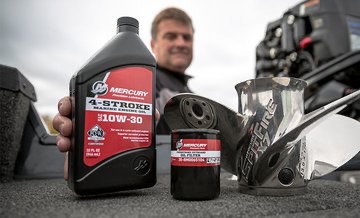
Fresh oil and a new filter keeps your outboard motor performing at its best. For long engine life, replace your oil every 50 hours of use.
#7 DRAIN AND REPLACE THE LOWER UNIT LUBE YEARLY
Ideally, this service is performed in the fall, see Lakeside Marine’s fall boat maintenance specials By doing this maintenance in the fall, the lower unit has no moisture or contaminates while being stored for winter.
There are two plugs for the lower unit, an upper and a lower screw. Remove both screws and let the gear oil drain fully. Then fill the unit with gear oil from the lower screw hole by squeezing the bottle, or using a pump until it flows out the top hole. Replace the upper plug first, and then the lower plug.
#8 PERIODICALLY REPLACE THE IMPELLER
Another fall boat service item is to periodically change the impeller that pumps the cooling water. Saltwater users should change the impeller every fall. Freshwater users may consider doing this every other year for peace of mind.

Periodically replace your impeller that pumps the cooling water. Avoid costly overheats by performing this required maintenance once a year for saltwater, and every two years for fresh water.
#9 WINTERIZE YOUR ENGINE
If you live in a cold climate, it is essential to winterize your motor. First, treat your fuel with a fuel stabilizer and fill your fuel tank full to minimize condensation and contaminated fuel.
Second, run your engine and feed a glycol-based antifreeze into the cooling water intake by submersing it in a bucket of antifreeze, or use a hose and pump. This will displace any water in the cooling system so it won’t freeze and cause damage. Run your motor long enough to pull the fuel stabilizer throughout the entire fuel system.
Third, disconnect your battery cables, and preferably store your battery indoors in a warm place. Put a battery charger on it mid-winter and before reinstallation in the springtime. If you do this, your battery will last a long time.
If you want the peace of mind of a professional mechanic performing your outboard motor winterization, check out Lakeside Marine’s boat winterization specials.
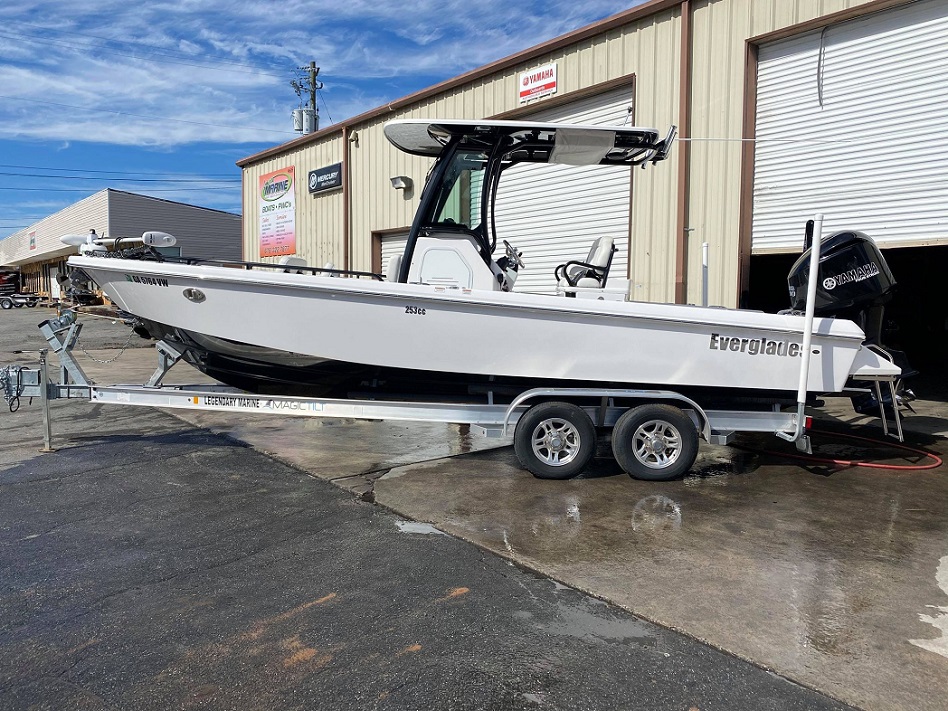
Winterize your outboard before the first cold snap. Change the oil and do a lower unit gear oil change at the same time.
#10 ESSENTIAL OUTBOARD MAINTENANCE FOR SALTWATER
If you run your motor in salt water, after every use you need to take a freshwater hose and flush your cooling system to minimize blockage and corrosion. Then hose off the entirety of the outside of the motor.
For outboards run in saltwater you will also need to periodically inspect and replace your anodes or zincs. These are pieces of aluminum or zinc that are attached to your motor at strategic places that minimize corrosion to the metal parts of your motor both inside and out.

For outboards run in salt water, periodically replace the anodes or “zincs”. The anodes protect the metal components from corrosion.
These outboard motor maintenance practices are easy to follow. If you do these simple things, your outboard motor will perform best and will last for many years to come.
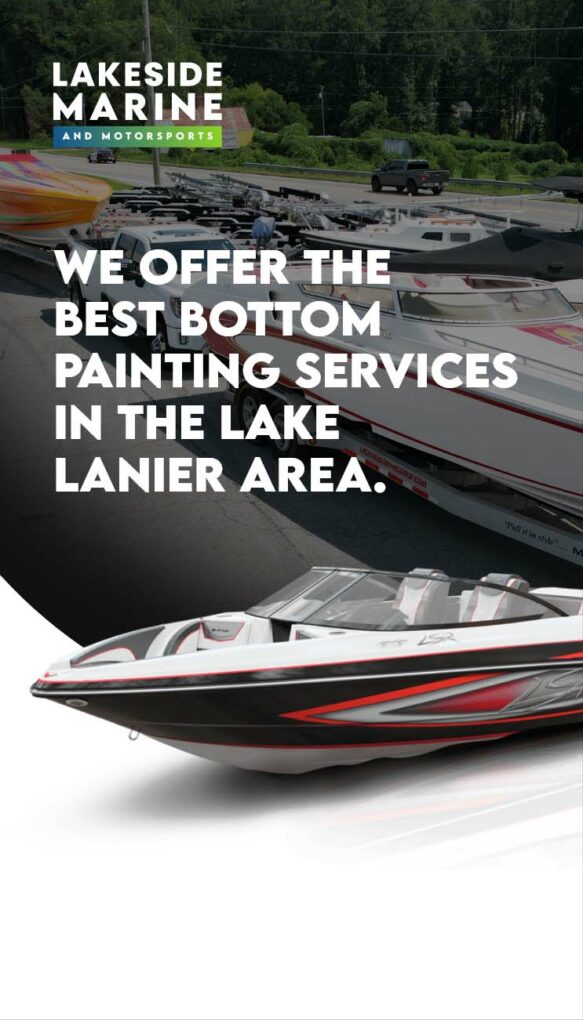
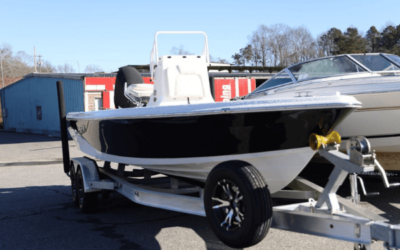
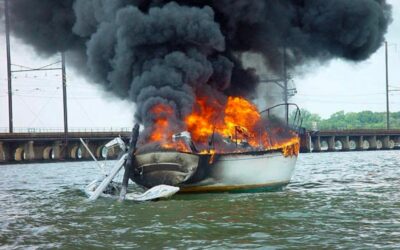

We are a group of volunteers and starting a new scheme in our community. Your website offered us with valuable information to work on. You have done an impressive job and our whole community will be thankful to you.
Oh my goodness! a tremendous article dude. Thank you Nevertheless I am experiencing difficulty with ur rss . Don抰 know why Unable to subscribe to it. Is there anyone getting identical rss drawback? Anybody who is aware of kindly respond. Thnkx
I just like the helpful info you supply for your articles. I will bookmark your weblog and check again here regularly. I am moderately sure I抣l learn many new stuff proper right here! Best of luck for the next!